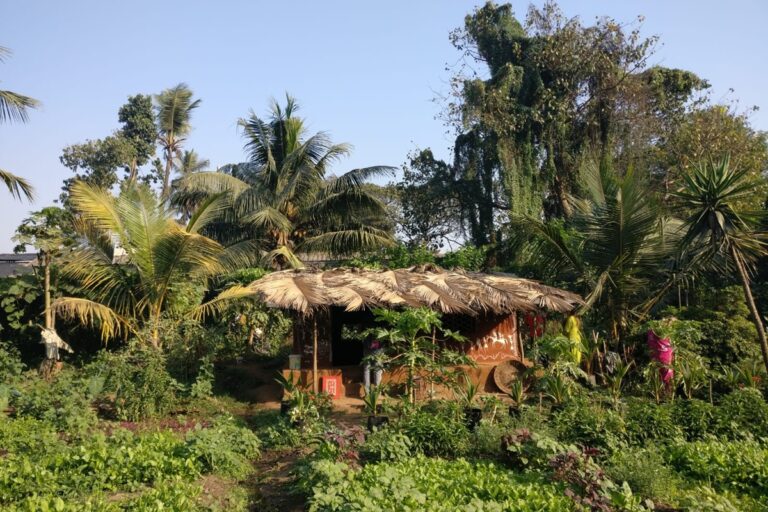- Mangrove habitats of Kochi in Kerala can store significant amounts of carbon for the long-term despite being heavily fragmented, according to a study. But they need immediate attention.
- Crab density, mangrove leaf litter and mangrove biomass shape the carbon sequestration potential of Kochi’s mangrove habitats.
- Mangrove habitats converted into aquaculture had very low carbon sequestration potential, found the study.
The highly fragmented 3.96 square km mangrove habitat of Kochi, an important port city flanked by the Arabian Sea on the country’s southwest tip, sequesters significant amounts of carbon, according to new research. Leaf-eating crabs, mangrove leaf litter and mangrove biomass are primary drivers of carbon storage and carbon burial rate in Kochi estuary’s mangrove-encrusted islets and habitats, the study said.
Led by scientists at the Cochin University of Science and Technology (CUSAT), the study examined the historic carbon burial rates (carbon sequestration potential) and carbon stock from three different mangrove soil habitats of the Kochi estuary in the state of Kerala. These studied mangrove-laden habitats, including a protected area, are exposed to varying degrees of human influence.
“The amount of sequestered carbon in Cochin (Kochi) mangroves is comparable to the amount stored in mangrove forests found globally. We dated the long-term storage and from that, we calculated carbon storage per hectare per year which gives us carbon sequestration potential. So on average 2.95-ton carbon per hectare per year was soil carbon sequestration potential for Cochin mangroves, which is equivalent to 10.62 ton carbon dioxide and this rate was higher than tropical forests,” Rani Varghese, the corresponding author of the paper, told Mongabay-India. S. Bijoy Nandan of CUSAT and Patrick T. Schwing of Eckerd College, Florida, are the co-authors.
A ton of carbon dioxide is equivalent to emissions from driving 6000 km in a diesel car or 366 litres of conventional diesel.
Kerala has lost 95 percent of the mangroves in the last three to four decades. From 700 square km in 1975, Kerala’s mangrove cover has drastically shrunk to up to 24 square km at present (as per the Kerala forest department). At least half of the mangrove areas in Kerala are under private ownership making them difficult to protect. Infrastructure development, aquaculture and other human activities and extreme weather events are contributing to the obliteration of these frontline climate defenders. The authors warn that these long-term carbon sinks are at risk of loss; protection and restoration of the mangrove cover are vital to safeguard the pool of buried carbon in the soil to prevent the release of carbon dioxide into the atmosphere and contributing to climate change.
The research underscores that mangrove habitats with a high density of leaf-eating crabs had a major effect on storing carbon in the soil while mangrove habitat disturbed by aquaculture had rather low carbon burial. “Crabs eat and process the leaf litter and help keep the litter in that ecosystem otherwise it would go into the estuary water,” said Varghese.
“The number of true mangrove species in Kerala is 18. In Kochi itself, there are 13. Avicennia officinalis and Rhizophora spp. are the dominant species. Avicennia marina is almost extinct in Cochin. No further disturbance should be allowed in these already-splintered mangrove areas. Having scientific data on carbon stock is an asset in convincing politicians to allocate funds for mangrove revival. Carbon stock data helps us understand which mangrove habitat should be preserved as it is, which habitat should be selected for plantation and the habitats where aquaculture should be halted. Funds are coming in through the United Nations’ Reducing Emissions from Deforestation and Forest Degradation (REDD) programme; these funds can be used for science-driven mangrove restoration,” added Varghese.

The highs and lows of carbon burial
For their analysis, scientists dug out 50 cm cores from the selected mangrove habitats to carry out radioisotope analysis. The mangrove soil samples were collected from Aroor, a semi-closed mangrove habitat; Malippuram on Vypin Island that is subjected to aquaculture farming since the 1980s and the island is the site of major construction projects such as the LNG Tunnel; and Mangalavanam Bird Sanctuary, a small, protected wetland in the centre of the city through which a sewage canal passes.
Aroor and Mangalavanam reported high carbon sequestration potential (up to 37.48-ton carbon dioxide per hectare per year) while Malippuram had a very low potential for carbon sequestration. Between Aroor and Mangalavanam, Aroor that was comparatively less-disturbed and had high biomass in the form of mangrove stands, high mangrove litter and high crab density exhibited the highest carbon burial (10.41 ton of carbon per hectare per year; 80 percent of carbon source in the form of litter was buried in soil).
“However, despite being a protected area and having the highest biomass among Cochin mangroves, Mangalavanam has recorded almost three times lower carbon burial (2.95-ton carbon per hectare per year; only 35.73 percent of carbon source as litter was buried),” observed Varghese. This could be attributed to a combination of natural and human activities. The site recorded a low litterfall rate and comparatively low crab density; researchers suspect the nutrient load from the sewage canal passing through the sanctuary contributes to the low carbon burial by altering the wetland habitats’ biogeochemistry.
The third sampled site, Malippuram on Vypin Island, showed depleted carbon burial (0.57 ton carbon per hectare per year, only 7.23 percent of carbon source which comes in the form of litter to the ecosystem was buried). Researchers note that the construction work on the island has cut off the saltwater supply to the mangroves, causing complete deterioration. “Setting up aquaculture farms requires reclamation of oil soil which interferes with the carbon sequestration potential of the mangroves,” Varghese said.
According to a Kerala forest department official who requested anonymity, the forest department aims to consolidate the remaining mangrove cover and acquire a section of mangrove-encrusted land that is under private ownership. “Around 100 years ago we used to have 700 square km of mangroves which has come down to 24 square km through the course of development and evolution. Roughly 4.25 square kilometres of the mangrove cover has been brought under the government. Half of the mangrove areas are under private ownership,” the official told Mongabay-India.
Under the Rebuild Kerala Initiative, which aims to rebuild the state post the 2018 floods, the forest department has planned to acquire 12 square km of mangrove-encrusted land that is under private ownership through prior informed consent and compensation payment as per the Management of Ecologically Fragile Lands Act, 2003. “We will adopt a people-inclusive approach to mangrove conservation after the acquisition,” the official said.
Varghese adds that long-term engagement with the local community is needed for targetted mangrove revival. She batted for repeated analysis to generate more long-term data to better understand the carbon storage potential of India’s blue carbon ecosystems.
Unlike other tropical forests, for which the bulk of carbon storage is in the biomass, mangrove carbon is primarily stored in the soil. The carbon stored in coastal and marine ecosystems is called blue carbon. Coastal ecosystems such as mangroves, tidal marshes, and seagrass meadows sequester and store more carbon per unit area than terrestrial forests and are now being recognised for their role in mitigating climate change.
According to a 2017 paper, natural climate solutions (NCS) can “provide over one-third of the cost-effective climate mitigation needed between now and 2030 to stabilise warming to below 2 °C.” Alongside aggressive fossil fuel emissions reductions, NCS offer a powerful set of options for nations to deliver on the Paris Climate Agreement while improving soil productivity, cleaning air and water, and maintaining biodiversity. The ecosystem services provided by mangroves are conservatively estimated at around £1.2 billion (USD 1.6 billion) globally, suggesting that no matter their size, they are key to meeting commitments like the Paris Climate Agreement.
While mangroves shield us from climate change-induced extreme weather events and are also known to trap plastic waste and stop it from entering the sea, this defence comes at a high cost to mangrove forests themselves.
A 2020 NASA study that created the first map of the causes of change in global mangrove habitats between 2000 and 2016, observed that the future sustainability of mangrove forests must consider the severity and intensification of extreme weather and ocean processes as increasingly important drivers of global losses. The study reported that while human activity has been a dominant cause of mangrove forest loss, but its impact has decreased since 2000.

Mangrove researcher P. Ragavan, post-doctoral fellow at Physical Research Laboratory, Ahmedabad, who was not associated with the study, pointed out that the actual potential of mangroves as nature-based solutions to climate change consequences is not reflected in India’s goals (Nationally Determined Contributions) to reduce national emissions and adapt to the impacts of climate change under the Paris Agreement.
India’s total annual GHG emissions have increased from 2,136.8 million tonnes (Mt) of carbon dioxide equivalent in 2010 to 2,607.5 Mt of carbon dioxide equivalent in 2014 (MoEFCC, 2018). The National Greenhouse Gas Inventory included blue carbon ecosystems (mangroves, seagrasses and salt-marshes) as mitigation measures against increasing GHG emission. “However, estimation of the ecosystem carbon stock and carbon burial rates of these habitats and understanding of spatial variability of carbon storage capacity of India’s blue carbon ecosystems are far from clear,” Ragavan told Mongabay-India.
“Blue carbon ecosystems are one of the best and cost-effective nature-based solutions for mitigation of and adaptation to increasing greenhouse gas emission and future climate change consequences respectively. However, their actual potential is not reflected in NDC (Nationally Determined Contributions) in many countries including India and more often presented based on the global averages. The lack of long term research on vegetated coastal habitats of India is the barrier to explore their actual potential,” added Ragavan.
Banner image: Rani Varghese, a Kochi native, works on phytoplankton sampling inside the mangrove habitat. Photo by Philomina Joseph.













